November 01, 2023
Unveiling Celestia: A Prelude to a Modular Blockchain Ecosystem and Its Token Dynamics
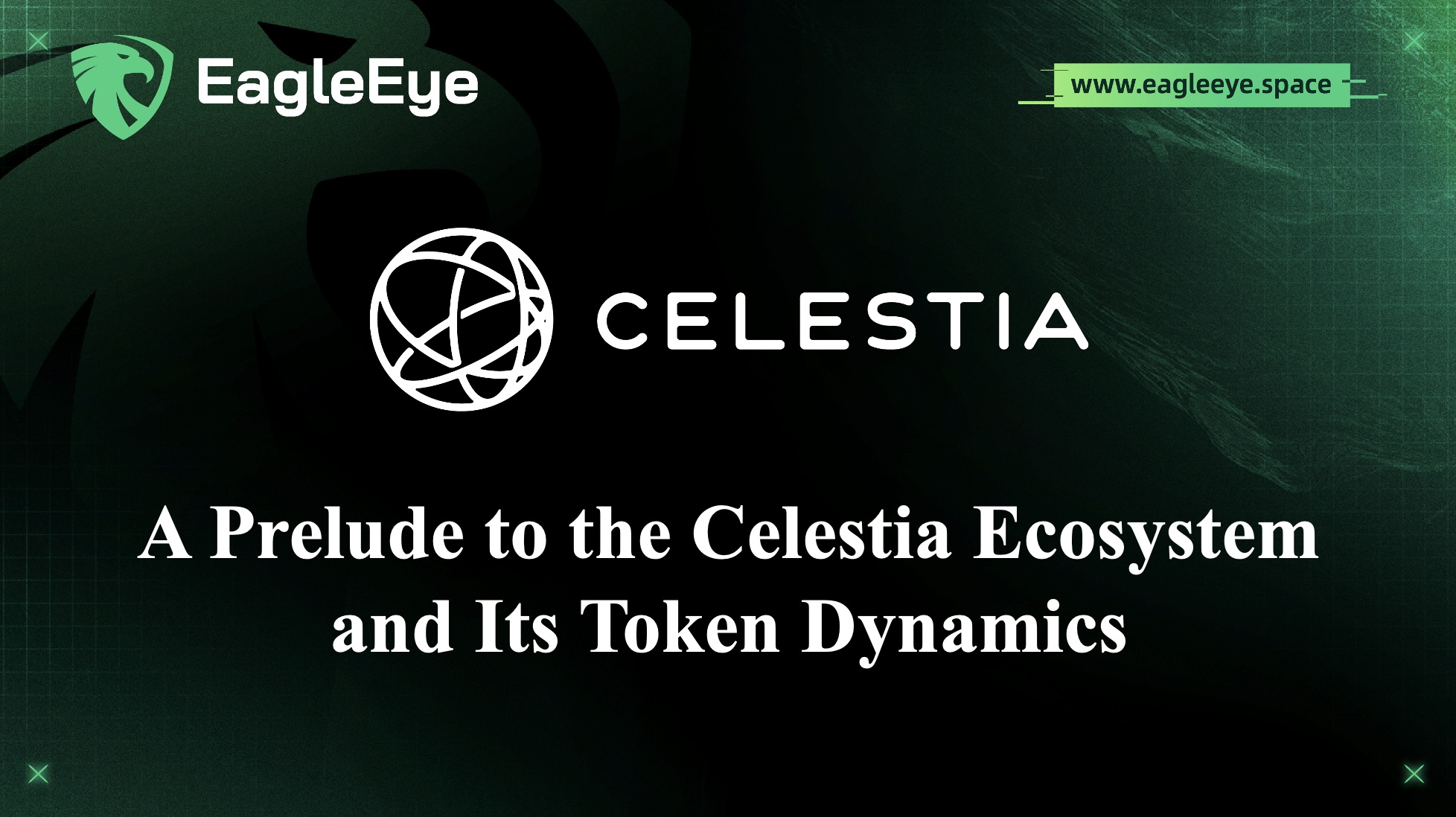
About EagleEye: https://eagleeye.space/
EagleEye is a Web3 B2C platform that allows users to analyze projects, addresses, risks, and relationships between projects. The platform can also help users monitor the projects and SmartMoney addresses they are interested in. EagleEye’s goal is to help Web3 users
Find α (alpha), Avoid Scam.
About the author: EagleEye community researcher — Alpha Hunter
wenshuang (Twitter Handle: @shuang_log2pi);
Eaton (Twitter Handle: @EatonAshton2);
Celestia’s core idea is to achieve a modular blockchain architecture, thereby enhancing scalability and customization. This article lists 7 noteworthy features of Celestia:
Celestia Features
A. Separation of Consensus and Execution Layers:
Traditional blockchain systems, like Bitcoin or Ethereum, merge consensus and execution into one layer. This means every node has to process and validate every transaction, which may lead to performance bottlenecks when facing a large volume of transactions. Celestia, however, decouples them, providing a pluggable consensus layer, allowing developers to deploy their execution layer on top of it.
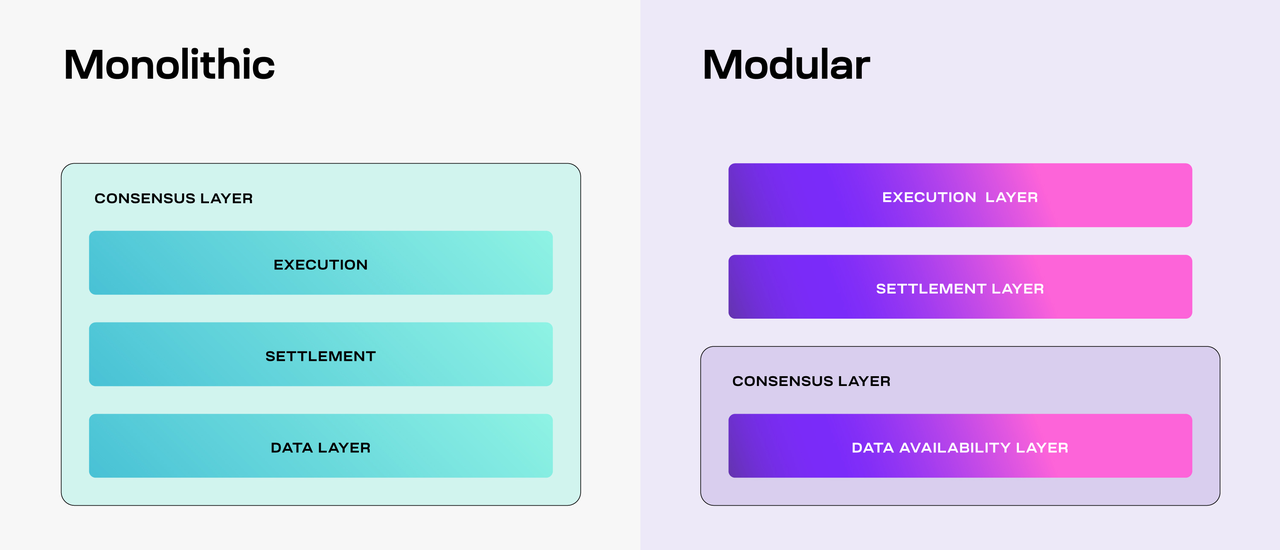
Celestia addresses performance issues by separating the consensus layer and execution layer. In short:

1. Execution Layer:
- The execution layer provides an environment where applications can thrive and handle state changes. In Celestia, the execution layer consists of Rollups, which are responsible for transaction execution. The Celestia team is focused on developing Optimistic Rollups on the settlement layer.
2. Settlement Layer:
- Currently, Celestia is collaborating with Evmos to develop the optimum settlement layer CEVMOS, based on EVM Rollup. It publishes all received data to the data availability layer. CEVMOS is a Rollup itself, providing a minimally trusted two-way bridge realized through dispute resolution contracts.
3. Consensus and Data Availability Layer:
- This layer is responsible for data availability and consensus mechanisms. All formats of data are transmitted to the data availability layer, essentially being Celestia. Nodes store data in the same format as received from the settlement layer. To incentivize node data storage, Celestia tokens will be introduced. This layer is intertwined with the consensus mechanism, which confirms block order to prevent security issues like double-spending. Celestia’s consensus mechanism utilizes Tendermint, adopting Byzantine Fault Tolerance (BFT) mechanisms.
- Celestia introduces an easily accessible data availability layer, allowing networks to publish their data through Celestia, eliminating the need for storing and validating data on their own chains.
Within the Celestia network, the separation of consensus and execution layers allows the network to concentrate on two main tasks: transaction ordering and data availability assurance.
For transaction ordering, Celestia’s consensus layer is responsible for transaction ordering and data availability assurance. It only takes on the role of publishing and ordering transactions, not executing them. By separating consensus and execution, Celestia provides developers with the ability to run their execution layers on top.
Secondly, regarding data availability and its verification, a more detailed explanation follows below, but in short, Celestia employs a two-dimensional Reed-Solomon encoding scheme to encode block data, allowing the network to verify data availability without executing transactions. Meanwhile, in Celestia, connecting chains becomes simple through light clients, requiring only the deployment of a smart contract.
B. Data Availability Proofs:
Simply put, Celestia employs a 2-dimensional Reed-Solomon encoding scheme to encode block data, enabling statistical certainty verification of the entire block being published with only a small portion of the data. If data encoding is erroneous, the network gets notified through data availability fraud proofs.
The specific implementation pathway of Celestia is:

1. Block Data Encoding: Celestia utilizes a 2-dimensional Reed-Solomon encoding scheme for block data encoding. Each block data is divided into k × k blocks, arranged into a k × k matrix, and expanded into a 2k × 2k extended matrix through parity-check data.
2. Merkle Root Calculation: 4k independent Merkle roots are calculated for the rows and columns of the extended matrix. The Merkle root of these Merkle roots is used as the block data commitment in the block header.
3. Data Sampling: To verify data availability, Celestia’s light nodes sample the 2k × 2k data blocks. Each light node randomly selects a set of unique coordinates in the extended matrix and queries the data blocks and corresponding Merkle proofs at these coordinates.
4. Scalability: Since each light node only samples a small part of the block data, resource-constrained light nodes can perform DAS. The more light nodes in the network, the more data they can collectively download and store. This allows for larger blocks (i.e., containing more transactions) while still keeping DAS feasible for resource-constrained light nodes.
5. Bandwidth Efficiency: For block data size of n² bytes, each light node must download O(n) bytes. Hence, enhancing the bandwidth capacity of Celestia light nodes has a quadratic effect on the throughput of Celestia’s data availability layer.
6. Fraud Proofs: The requirement to download 4k intermediate Merkle roots is a result of using the 2-dimensional Reed-Solomon encoding scheme. Additionally, DAS could be designed using standard (i.e., 1-dimensional) Reed-Solomon encoding, where the original data is divided into k blocks, and expanded with k additional parity-check data blocks.

Through Data Availability Sampling (DAS) technology for blockchain scaling solutions, Celestia achieves efficient data availability and scalability, while ensuring data integrity and security.
C. Off-chain Execution Rollups:
Celestia is suitable for rollup scaling solutions, pushing state execution off-chain, and relying on the base chain for consensus and data availability. Optimistic rollups require data availability to detect fraud, while zk rollups need data availability to rebuild the chain’s state.
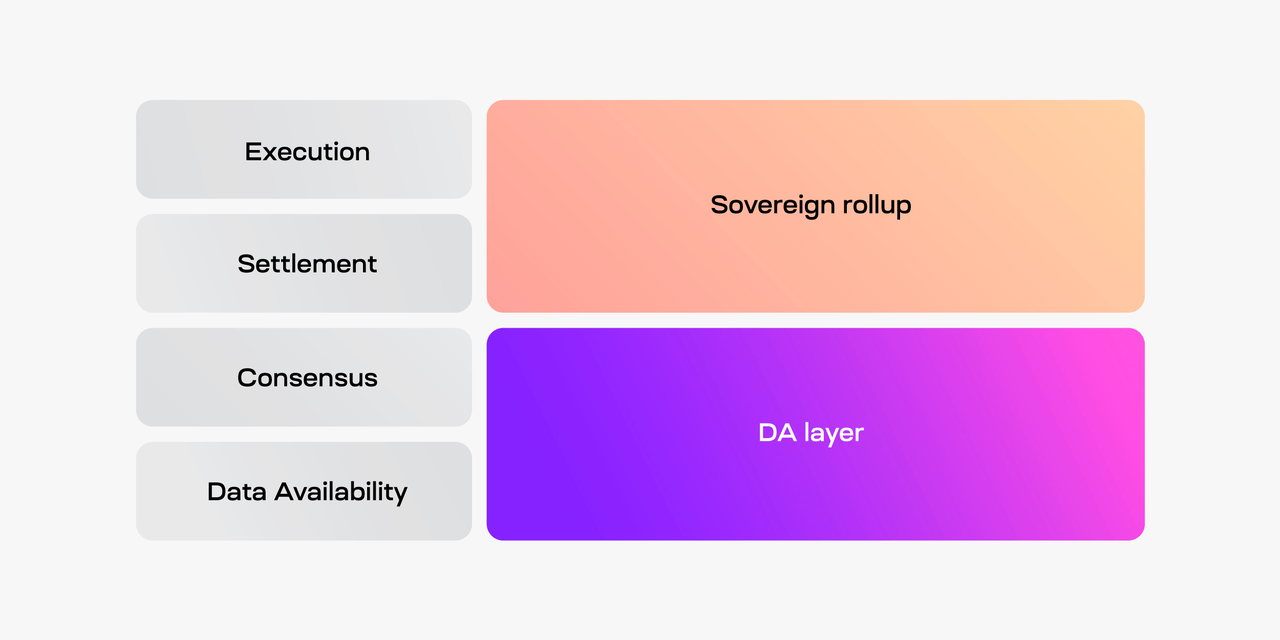
Initially, Celestia’s core design choice is to minimize on-chain state as much as possible, thereby creating a minimally invasive DA layer. This means Celestia does not have an on-chain smart contract environment, nor does it act as a “settlement layer” (i.e., bridging hub) for Rollup use, developers can deploy their settlement layers and shared security clusters on Celestia.
Within the Celestia network, there’s a design called Sovereign Rollup, offering a new blockchain design concept. It differs from Ethereum’s smart contract Rollup, where smart contract Rollup verifies transactions through Ethereum’s smart contracts, while Sovereign Rollup verifies transactions through its nodes.
Firstly, Sovereign Rollup is designed as an independent, sovereign chain, where traditional Rollup chains are defined by the Rollup subnet itself, akin to independent first-layer (L1) blockchains. They can selectively establish trust or minimally trusted bridges with other chains or settlement layers. Secondly, traditional Rollups usually rely on a main chain (like Ethereum) as a settlement layer, but Sovereign Rollup doesn’t use a settlement layer to determine its canonical chain and validity rules.
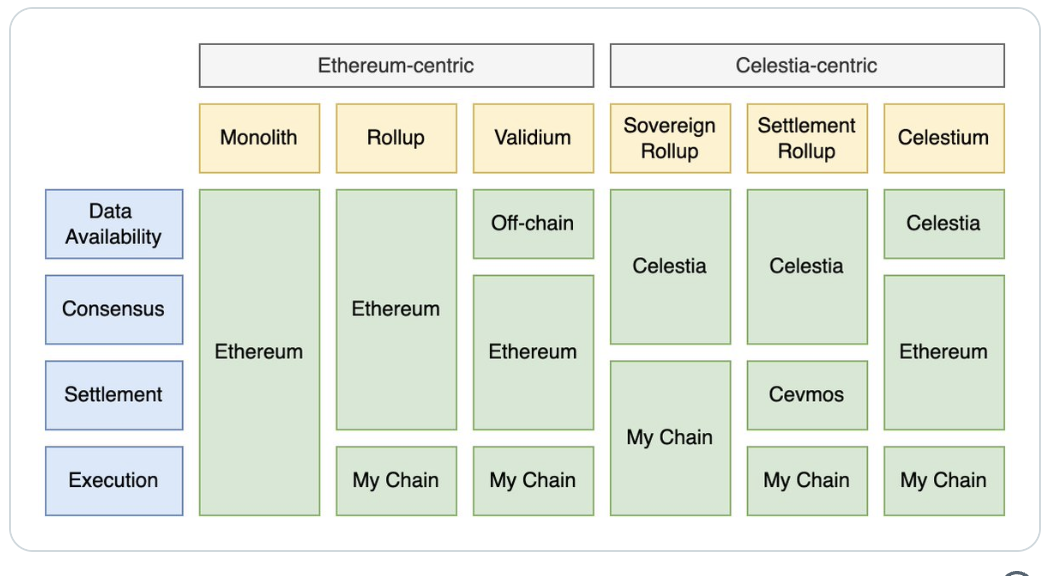
Source: https://blog.celestia.org/sovereign-rollup-chains/
In Celestia, Sovereign Rollup doesn’t publish its blocks to smart contracts, but directly publishes them as raw data to the chain. This implies settlements occur on the Rollup instead of on a separate settlement layer. Celestia’s consensus and data availability layers do not interpret or compute Rollup blocks, nor do they run on-chain light clients for Rollup.
Contrary to smart contract Rollups which require upgrades through modifications on smart contract within the settlement layer, Sovereign Rollups upgrade through forking, similar to first-layer blockchains. New software versions are released, and nodes can choose whether or not to update to the latest version. If nodes disagree with the upgrade, they can continue using the old software, thus offering a choice to the community.
For specific comparison dimensions, see the chart below:

D. Secure Light Clients for Interoperability:
In the Celestia network, secure Light Clients play a crucial role for interoperability. They primarily ensure the network’s security, scalability, and interoperability through Data Availability Sampling (DAS).
Initially, light clients are nodes that don’t require downloading and validating the entire blockchain; they typically only validate block headers and verify block data availability through random sampling. They are designed to operate in resource-constrained environments (like mobile devices) while maintaining a level of security and interoperability. Celestia’s network design mainly provides consensus and data availability, not transaction execution. Similarly, Celestia’s light clients do not verify transactions; they only check if consensus has been reached for each block and if block data is available to the network.
Through the aforementioned 2-dimensional Reed-Solomon Merkle Tree (rsmt2d) encoding scheme, Celestia’s light clients can verify with high probability whether the rest of the block has been published by sampling a small amount of block data randomly. If any full node detects suspicious behavior, they can notify the light clients through data availability fraud proofs. Light clients are key components of blockchain interoperability standards like IBC. Improved security of Celestia’s light clients implies chains built on Celestia have stronger interoperability security assurances.
E. Modular Architecture and Data Network:
Celestia is a modular consensus and data network, aimed at enabling anyone to easily deploy their own blockchain with minimal overhead. Celestia is a minimal blockchain, only responsible for ordering and publishing transactions, not executing them. By separating the consensus and application execution layers, Celestia offers a simplified L1 solution for developers and users, only responsible for sorting and publishing arbitrary data provided by any developer and user, without performing any computation on the data.
F. PoS Consensus Mechanism:
Celestia operates on a Proof of Stake (PoS) consensus mechanism, inclusive of an easily accessible Data Availability (DA) layer. The DA layer allows networks to publish their data through Celestia, eliminating the need to store and validate data on their own chains.
Celestia’s PoS consensus mechanism is based on CometBFT and Cosmos SDK. In Celestia’s network, there is an initial set of validators, totaling 100, responsible for the network’s consensus process. Validators and delegates can participate in the network’s consensus mechanism by staking TIA tokens, thus earning staking rewards from the network. Validators charge a fee to delegates in exchange for a portion of the staking rewards.
Its operation is similar to the PoS consensus mechanism in Cosmos SDK. In the Cosmos network, any user can help protect the network by delegating their TIA tokens to Celestia validators and earn a portion of the validators’ staking rewards. Similarly, Celestia provides a pluggable consensus layer, allowing developers to deploy their execution layer on top of it, thus offering more customization and autonomy for applications built on Celestia.
In Celestia’s network, validators and delegates participate in the consensus process by staking TIA tokens, thus earning staking rewards from the network. Validators are responsible for validating transactions, while delegates can delegate their tokens to validators and earn a portion of the validators’ staking rewards. This design helps safeguard the network’s security while incentivizing network participants to maintain the network’s proper functioning.
Currently, on the testnet, the latest block height of Celestia beta version is 323,070, with a block time of 11.56 seconds, comprising 209 valid validator nodes, 100 of which are active. The community pool has 2.12 million TIA.
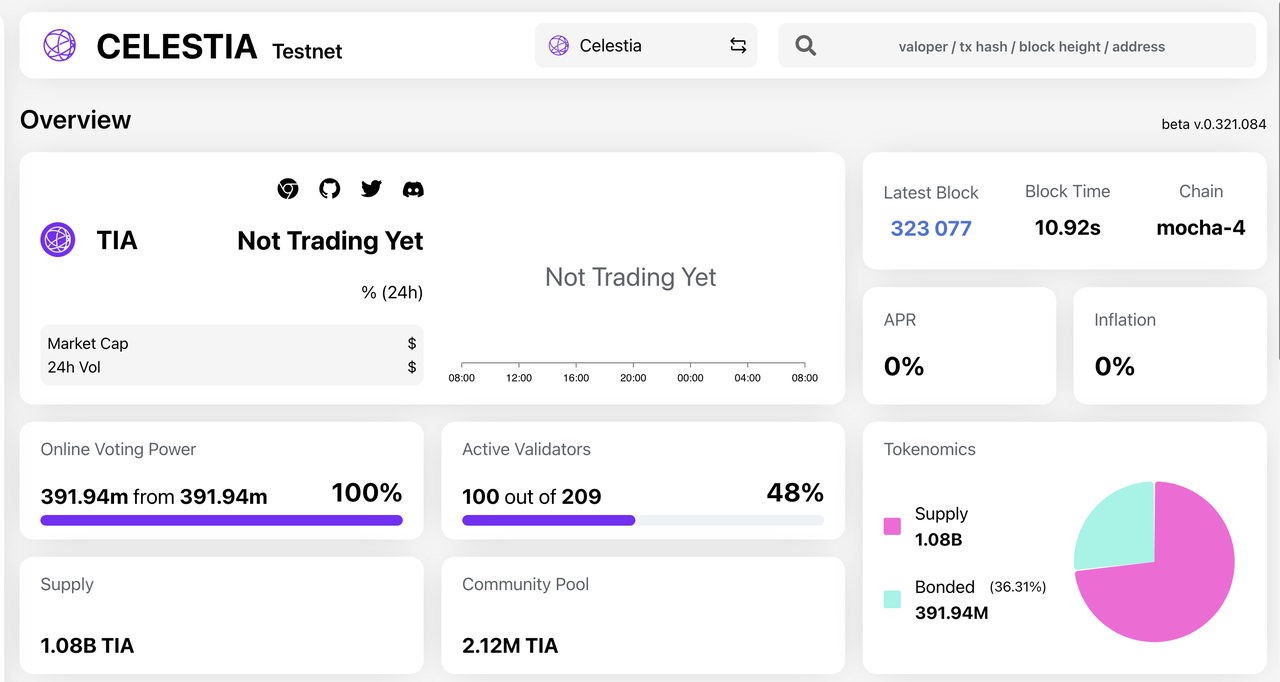
Currently, Celestia’s ecosystem is in the initial construction stage, with each sub-category having around 3–6 projects. The overall activity is just starting since Celestia has not officially launched yet. Post-launch, it’s crucial to pay attention to the ecosystem’s performance.
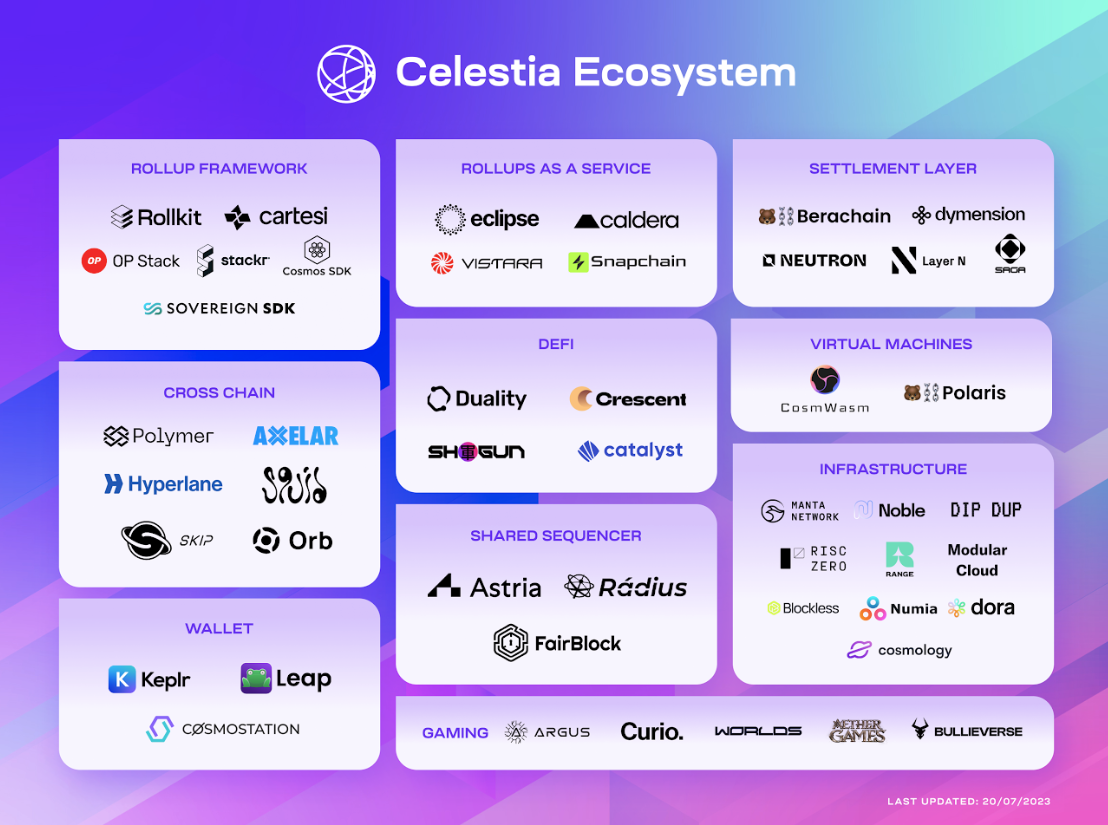
Celestia Token Model:

TIA tokens in the Celestia network are initially distributed across five major categories. Public distribution constitutes 20%, which includes a Genesis dividend and testnet incentives at 7.4%, and future initiatives at 12.6%. 26.80% of the tokens are allotted to the Celestia Foundation and core developers for research and ecosystem initiatives. Early supporters are divided into Series A&B holding 19.70% and Seed holding 15.90%. Lastly, the initial core contributors category holds 17.60%, distributed to the first batch of core contributors from Celestia Labs.
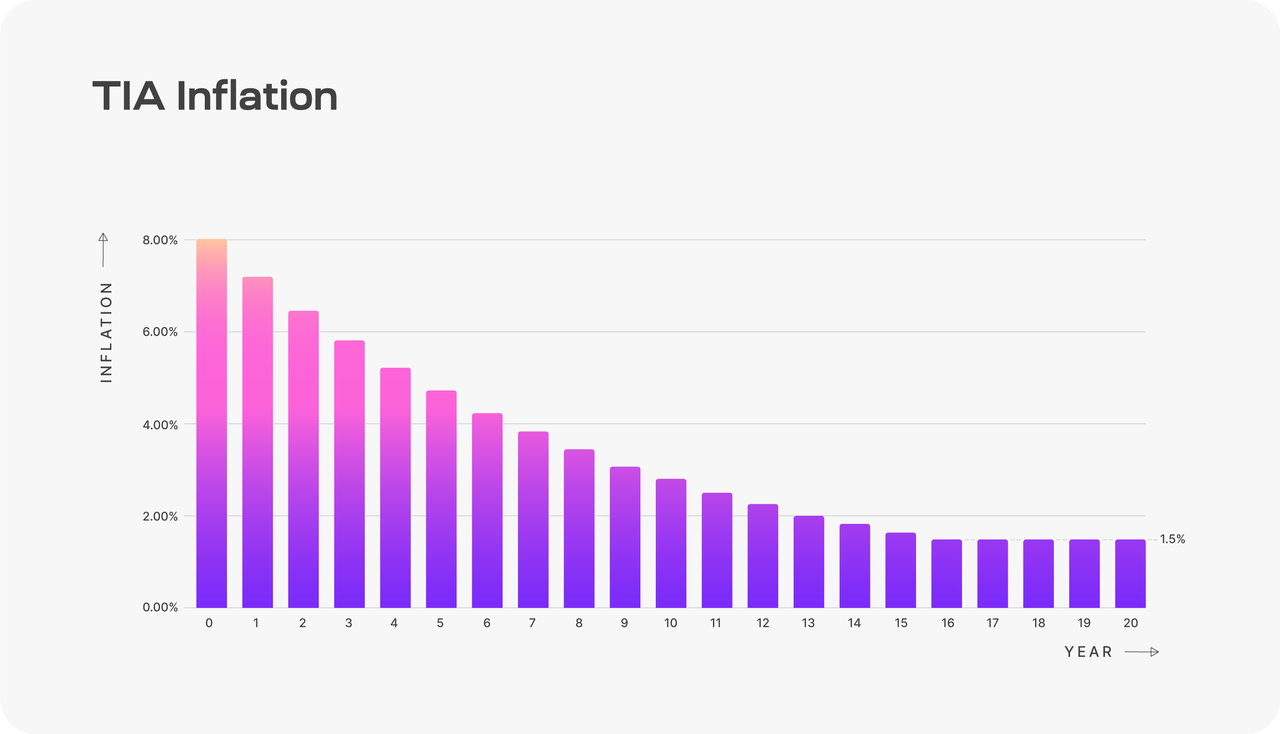
Roles of TIA:
- Pay for Data Availability Fees: Developers submit PayForBlobs transactions and pay fees with TIA to ensure data availability on the Celestia network.
- Launch New Rollups: Developers can use TIA as gas tokens and currency to quickly launch their chains, avoiding the need to issue new tokens immediately.
- Proof of Stake (PoS) Security Mechanism: Users delegate TIA to validators to help secure the network and can earn a portion of the validators’ staking rewards.
- Governance: TIA holders can participate in the network’s decentralized governance, voting on network parameters and managing the community pool, among other things.
Celestia Airdrop:
Celestia’s token airdrop program aims to incentivize and reward specific participants within the community, including blockchain researchers, public goods providers, early modular ecosystem contributors, early adopters of Ethereum rollups, and stakers and IBC Relayers on Cosmos Hub and Osmosis. Each category has clear eligibility criteria and token allocation quotas. This airdrop covers 7,579 developers and 576,653 on-chain addresses on Ethereum Rollups, Cosmos Hub, and Osmosis.

The Celestia token airdrop program is divided into four categories. The first category rewards blockchain researchers and public goods providers, including GitHub contributors to mainstream blockchains and protocols, as well as Eth Research contributors, with a total of 20,000,000 TIA tokens. The second category is for early modular ecosystem contributors, primarily participants in modular summits and specific GitHub contributors. The third category is for early users of Ethereum rollups, specifically active users of the top 10 Rollups on L2Beat by TVL, with a token allocation of 20,000,000 TIA. The final category is for stakers and IBC Relayers on Cosmos Hub and Osmosis, where stakers will receive a minimum airdrop of $75 based on their staking amount and activity, also with a token allocation of 20,000,000 TIA.
Related Project
Related Project Secure Score
Guess you like
.png)
Unibot Exploited - Examining the Security Risks of Telegram Bots
October 31, 2023

Blockchain Security Recap of October: $51.61M Lost in Attacks
November 01, 2023
Focusing on EVM and Cosmos SDK chains, Beosin provides security services for the Celestia ecosystem
November 01, 2023
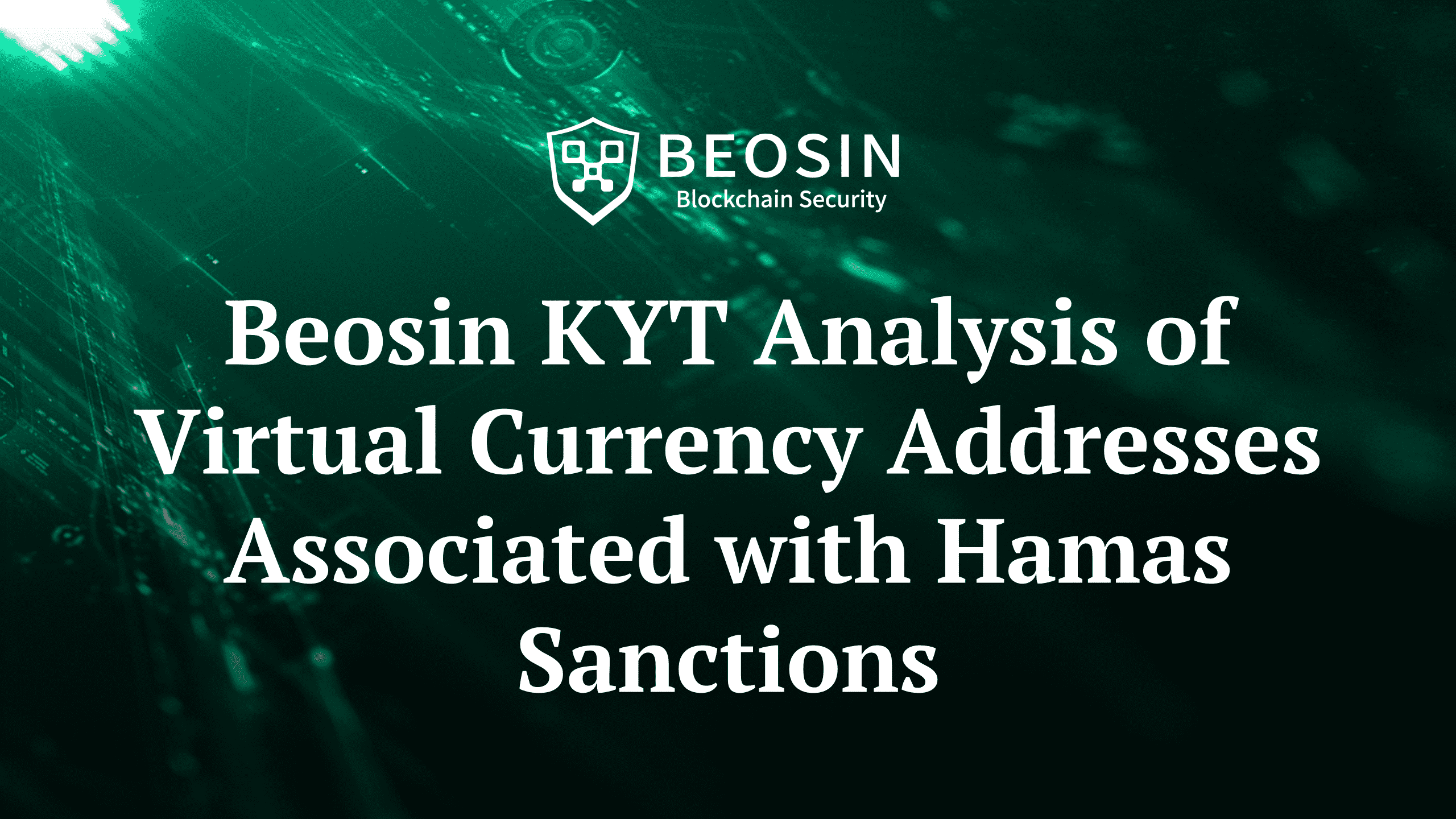
Beosin KYT Analysis of Virtual Currency Addresses Associated with Hamas Sanctions
November 03, 2023

